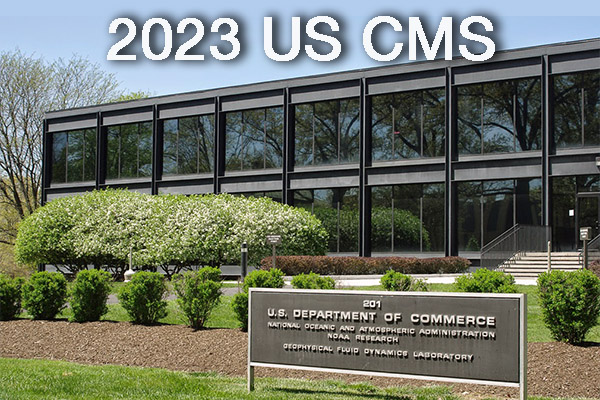Reflections from the US Climate Modeling Summit
To improve the coordination and communication of national climate modeling goals and objectives, USGCRP’s Interagency Group on Integrative Modeling (IGIM) convenes an annual U.S. Climate Modeling Summit (USCMS), beginning in 2015. The Summit brings together representatives from the U.S. “CMIP-class” climate model development centers and from operational climate prediction programs. Since 2017, each summit has included a topical workshop organized by the modeling centers, followed by the summit meeting.
Leaders of six federally funded US climate modeling centers (DOE/E3SM; NASA/GISS; NASA/GMAO; NOAA/EMC; NOAA/GFDL, NSF/CESM) and representatives from many leading experimental and operational climate modeling programs gathered at NOAA’s Geophysical Fluid Dynamics Laboratory and virtually for the ninth annual US Climate Modeling Summit (USCMS) on April 24-26, 2023. This summit was co-organized by John Dunne of GFDL and Ruby Leung of DOE.
This year’s workshop centered around a theme of the oceans’ role on air – sea coupled climate interactions, and was split into three sessions:
- coupled tropical-subtropical air-sea interactions on subseasonal to multi decadal time scales,
- the role of air-sea interactions in extreme events, and
- advances in modeling ocean and air-sea boundary interactions to address large scale biases.
Four speakers represented DOE at the workshop: Steve Brus of ANL gave a presentation on the impact of a wave-dependent surface flux parameterization on the mean wave climate and Madden-Julian Oscillation (MJO); Chris Patricola of Iowa State University gave a presentation on the Influence of ocean coupling on future projections of tropical cyclones; Karthik Balaguru of PNNL gave a presentation the enhanced US hurricane risk under global warming: the role of tropical SST warming patterns; and Samson Hagos of PNNL gave a presentation on the influence of surface-atmosphere interactions in the propagation of MJO and implications for landfalling atmospheric rivers. Gary Geernaert, the IGIM chair and the Acting Associate Director of DOE Office of Biological and Environmental Research, attended in person. Participating DOE program managers include Xujing Davis, Renu Joseph, both in person and Bob Vallario remotely.
Immediately following the workshop, the summit meeting was attended by the 12 representatives of the 6 US climate modeling centers and the agency program managers. The summit meeting included updates on various collaborative activities that have resulted from previous workshops, updates on activities at the modeling centers, and presentations on special topics of interest.
A report on the ninth annual USCMS will be finalized in the coming months and made publicly available, along with past USCMS reports, on the IGIM resources website.
References
This article is a part of the E3SM “Floating Points” Newsletter, to read the full Newsletter check:



